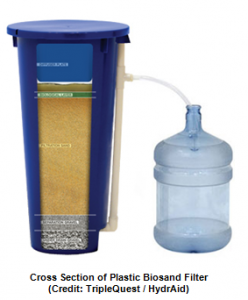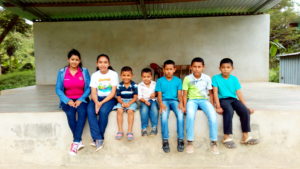By Eva Jimenez, PWW Honduras Volunteer
 Biosand water filters need to be used every day to ensure proper functioning. The “bio” part of the Biosand filter refers to the biological layer, a bacterial layer formed on the top of the sand that needs to be wet to keep the “good” bacteria fed and alive. Once dried out, the bacteria die and the filter losses its effectiveness.
Biosand water filters need to be used every day to ensure proper functioning. The “bio” part of the Biosand filter refers to the biological layer, a bacterial layer formed on the top of the sand that needs to be wet to keep the “good” bacteria fed and alive. Once dried out, the bacteria die and the filter losses its effectiveness.
Schools can be a challenging environment to keep a Biosand filter functioning at its highest possible level. Schools in Honduras, for example, close for extended periods during holidays, heavy rains, and crop harvesting. Some schools will have a neighbor take care of the filter while school is closed, but for many that is not always possible.
For this reason, PWW conducted an experiment in local Honduras schools, in 2014, to test the effectiveness of Biosand filters when restarted after a long period of being abandoned (unused). (read related blog: July 2015)
For this study, 10 filters were installed in 9 schools. The filters confirmed to be working effectively during the school year and abandoned during the school break (from November to February). Before the children came back to school, water was either poured into the filters three times a day over the course of one week or once a day over the course of two weeks. Biological analyses were conducted, and it was proven that all of the filters were working 100%.
 Río Arriba school was one of the schools selected for this experiment. The school has almost 100 children under the age of 12. Some children live close to the school, some walk more than one hour to participate in classes. There are two filters at Río Arriba, and every day two classes are given the responsibility of taking care of them.
Río Arriba school was one of the schools selected for this experiment. The school has almost 100 children under the age of 12. Some children live close to the school, some walk more than one hour to participate in classes. There are two filters at Río Arriba, and every day two classes are given the responsibility of taking care of them.
Ruth E. Díaz, Río Arriba’s School Director, told us how important this is for the children for several reasons. During this time they learn the importance of drinking safe water (I am witness to this; they know the filter can remove harmful bacteria, viruses and parasites). They also learn how to properly use the filter and how to clean the accessories.
But they also gain something that is often not taken into account. Children at this school no longer need to carry water bottles from home. This is especially important for those living far away.
The filters and hygiene education at school have given these children both the gift of safe water and an understanding of the importance of safe water in their lives. They now have this knowledge and the ability to share it with future generations.
In November of 2017, a chart demonstrating this study was published by the following research team: Cordelia Stewart (Bowdoin College), Barbara Stewart (Bangor High School), Catherine Hopper (University of Maine), Ellen Tobin (Water for ME), Kirsty Moriarty (Water for ME), Julia Fasse (Tufts University), and Carolyn Meub (Pure Water for the World).
The chart demonstrates the process and results of a collaborative field study conducted to determine the viability and performance of the biosand filter on a school schedule with intermittent use.
View Biosand Filter Field Study Chart: Periodic Abandonment.
The research team will return this July to continue their research and testing efforts.
